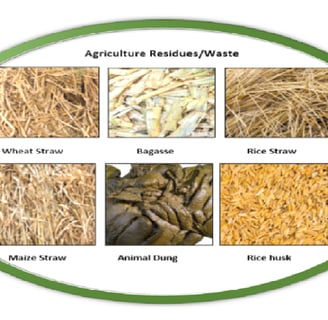Sustainable Disposal of Agricultural Residues via Green Technologies
Agricultural residues and waste can be converted into various energy products employing green technologies. Keeping in view the crop growth pattern in Pakistan, it is estimated that 11000 to 16000 MW electricity can be produced from agricultural residues by 2035 employing green technologies
Dr. Muhammad Rizwan Tabassum, Incharge Punjab Bioenergy Institute (PBI), Assistant Professor, Punjab Bioenergy Institute (PBI), Department of Energy Systems Engineering, University of Agriculture, Faisalabad (m.tabassum.pbi@uaf.edu.pk), Dr. Muhammad Shahzad, Assistant Professor, Department of Energy Systems Engineering, University of Agriculture, Faisalabad. Dr. Arifa Mahreen, Department of Zoology, Community College, PARS Campus, University of Agriculture, Faisalabad
8/1/20242 min read


Agricultural residues and waste such as wheat straw, rice straw, rice husk, bagasse etc. can be disposed off employing green technologies such as anaerobic digestion, fermentation, composting, gasification, pyrolysis etc. Additionally, various energy products can be recovered from biomass employing theses green technologies. It is estimated that globally 1300 million tons of agricultural waste is produced while in Pakistan this estimate is around 80-100 million of tons of the waste annually. Keeping in view the crop growth pattern in Pakistan, it is estimated that 11000 to 16000 MW electricity can be produced from agricultural residues by 2035 employing green technologies. Thermochemical and biochemical conversion technologies are two main types of green technologies that convert agricultural residues/waste into energy products such as syngas, biochar, hydrogen, biogas, biomethane, biooils etc. A brief description is as under;
1. Green Thermochemical Conversion Technologies: Agriculture residues can be converted into various types of energy products employing thermochemical conversion technologies.
1.1 Gasification: Biomass can be gasified to produce syngas, hydrogen and methane at very high temperature that can be utilized to generate electricity.
1.2 Pyrolysis: Syngas and bio-oil can be produced through pyrolysis process. Slow and fast pyrolysis process works at moderate to high temperature (350-450 C) in anoxic-conditions. This process ensures that all agricultural waste is converted into renewable energy products.
2. Green Biochemical Conversion Technologies
2.1 Anaerobic digestion: This is a biochemical conversation method that works at very low temperature (35-50 C) to save energy inputs and mild reaction conditions. This not only converts agricultural residues into energy product (biometahne) but also provides green organic fertilizer for soil enrichment. Sustainable waste disposal, energy recovery and provision of organic fertilizer are the key features with additional benefit of climate change mitigation technology.
2.2 Fermentation: To convert the waste and residues into bioethanol, biobutanol and biohydrogen, fermentation of the waste material is the best choice. However, cost effectiveness and scale-up are the key bottlenecks.
2.3 Composting: It is a recycling of agricultural waste to make it a soil enrichment recipe because agricultural waste recycling is very important step for sustainable agriculture practices.
Conclusion: Green technologies have the potential to generate 11000 to 16000 MW electricity from agricultural residues by 2035 as per estimated growth rate of crops in Pakistan.
